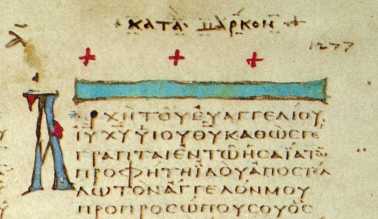
Wednesday, March 31, 2010
Gospel Inscriptions

When were the Gospel inscriptions (e.g., KATA MARKON ["According to Mark"]) added? Received wisdom was that they were added during the collection and ratification of the Fourfold Gospel collection in the mid-second century (A. von Harnack, T. Zahn). Some would even claim, like Rudolf Pesch, that "all the inscriptions and subscriptions in the Gospel manuscripts are late" [alle Inskriptionen und Subscriptionen in den Evangeliuenschriften sind spat]. However, this view was strongly contested by the late scholar Martin Hengel who argued that:
(1) There is no evidence that shorter readings like KATA MARKON found in codex Vaticanus were more primitive than the longer readings like EUANGELION KATA MARKON, since the earliest papyri all attest the longer reading.
(2) The title EUANGELION KATA MARKON etc. cannot be attributed to the fixing of the fourfold Gospel canon in middle to late second century in order to differentiate the books from each other because Aristides (Apol. 2; 16) and Justin (Apol. 66.3) both know of euangelia (‘Gospels’ in the plural) and in the case of Justin there is an awareness that the Gospels derive from the apostles and their followers (Dial. 103.8).
(3) Marcion’s preference for Luke (ca. 144 CE) was perhaps based on his agreement with its title and tradition that already attributed it to a disciple of Paul as opposed to the judaizing Gospels of Matthew and John.
(4) The statement attributed to Papias about the origins of the Gospels assumes a titular distinction between the Gospels. Furthermore, if Papias got his information from John the Elder around 90-100 CE, then the John Mark-Peter link found in Papias' statement cannot have been derived from 1 Pet 5.13 since 1 Peter was pseudepigraphically written during this same period at the time of Domitian in the 90s.
(5) The titles of the non-canonical Gospels, some of which can be dated to the mid-second century (e.g., Gospel of Thomas, Gospel of Peter, Gospel of the Ebionites, etc.), are to be understood as a deliberate imitation of the titles of the canonical Gospels. Likewise, Basilides, the Alexandrian Gnostic in the early second century, wrote a twenty-four volume Gospel commentary that perhaps included a titular distinction between the Gospels as well.
(6) The longer ending of Mk. 16.9-20 and the Epistula Apostolorum, dated to the first half of the second century, presuppose the circulation of the Gospels and Acts.
(7) While the Gospels are strictly anonymous at the literary level, that was possible only because their authorship and origin would have been known in its immediate setting. Anonymous works were rare in antiquity and regarded with suspicion, hence the rise of pseudepigraphy. Tertullian (Adv. Marc. 4.2.3) went so far as to say that a Gospel not bearing the name of its author was not to be received because he knew of some Gospels that had titles (canonical Gospels and perhaps others) and those that did not (Marcion). Yet the titles were probably added to the Gospels very early on in order to identify the origin of the work when the Gospels were used in liturgical practice, disseminated further afield, or arranged in Christian libraries. If the Gospels were utterly anonymous (author and provenance) and circulated with no knowledge of their origins, then, this would have led to a multiplicity of titles that we do not find at all. Thus, the titles were not added at the final redaction of the Fourfold Gospel collection in the middle of the second century, but were probably given during the dissemination of the Gospels to other communities when Christian scribes added the names based on collective knowledge about their authorship and origins.
Subscribe to:
Post Comments (Atom)




3 comments:
Dr. Bird,
I have often wondered what all is connoted by the red (in sinaiticus; looks black in the image you posted) etching around the titles.
In Sinaiticus red print seems to mark "added" material. The inscriptions of the Psalms are printed in red.
Do you think this etching connotes an attitude of uncertainty or humilty regarding the origin of the Gospel titles?
I started reading the post and was going to comment, "Oh, Hengel talks about this....." And then you go off and cite Hengel the rest of the post.
I think Hengel quite correct...the titles, regardless of form, seem early second century at the latest and are completely unrelated to the canonical process.
Hey Mike,
What evidence does Hengel supply for the claim that "the Gospels are strictly anonymous at the literary level"? If no copies are missing the titles, then how do you know this? It'd be like me saying that "strictly speaking, the Gospel of John lacks an opening chapter at the literary level," even though every manuscript we have has one. Huh? Who would accept that logic?
Moreover, I remember being struck by Richard Burridge's puzzlement in his book on the genre of the Gospels. Burrdige notes that that the four Gospels resemble Greco-Roman biographies in every detail but ONE: biographies ALWAYS have titles, while the Gospels are "anonymous."
The whole time I was reading I was thinking; Hey, Richard, what evidence do you have for the anonymity of the Gospels? If other Greco-Roman bioi were always published with titles, why not just grant that the titles are original? That's what we'd do with any other textual element that appears in every manuscript.
The question then is, of course: What are the implications for authorship? If the titles are original and within the living memory of Jesus' disciples, what does this suggest about who wrote them?
Have a blessed Easter.
Post a Comment